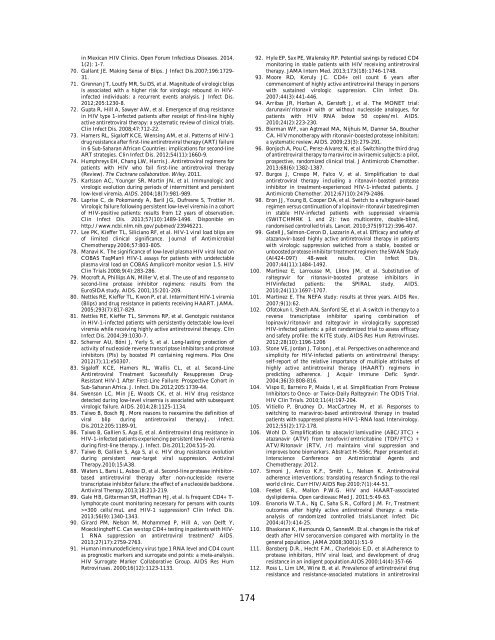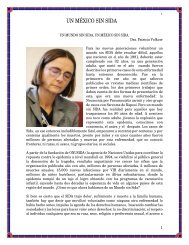GUÍA MANEJO ANTIRRETROVIRAL PERSONAS VIH
G_ARV2016_1
G_ARV2016_1
You also want an ePaper? Increase the reach of your titles
YUMPU automatically turns print PDFs into web optimized ePapers that Google loves.
in Mexican HIV Clinics. Open Forum Infectious Diseases. 2014.<br />
1(2): 1-7.<br />
70. Gallant JE. Making Sense of Blips. J Infect Dis.2007;196:1729-<br />
31.<br />
71. Grennan JT, Loutfy MR, Su DS, et al. Magnitude of virologic blips<br />
is associated with a higher risk for virologic rebound in HIVinfected<br />
individuals: a recurrent events analysis. J Infect Dis.<br />
2012;205:1230-8.<br />
72. Gupta R, Hill A, Sawyer AW, et al. Emergence of drug resistance<br />
in HIV type 1-infected patients after receipt of first-line highly<br />
active antiretroviral therapy: a systematic review of clinical trials.<br />
Clin Infect Dis. 2008;47:712-22.<br />
73. Hamers RL, Sigaloff KCE, Wensing AM, et al. Patterns of HIV-1<br />
drug resistance after first-line antiretroviral therapy (ART) failure<br />
in 6 Sub-Saharan African Countries: implications for second-line<br />
ART strategies. Clin Infect Dis. 2012;54(11):1660-9.<br />
74. Humphreys EH, Chang LW, Harris J. Antiretroviral regimens for<br />
patients with HIV who fail first-line antiretroviral therapy<br />
(Review). The Cochrane collaboration. Wiley. 2011.<br />
75. Karlsson AC, Younger SR, Martin JN, et al. Immunologic and<br />
virologic evolution during periods of intermittent and persistent<br />
low-level viremia. AIDS. 2004;18(7):981-989.<br />
76. Laprise C, de Pokomandy A, Baril JG, Dufresne S, Trottier H.<br />
Virologic failure following persistent low-level viremia in a cohort<br />
of HIV-positive patients: results from 12 years of observation.<br />
Clin Infect Dis. 2013;57(10):1489-1496. Disponible en<br />
http://www.ncbi.nlm.nih.gov/pubmed/23946221.<br />
77. Lee PK, Kieffer TL, Siliciano RF, et al. HIV-1 viral load blips are<br />
of limited clinical significance. Journal of Antimicrobial<br />
Chemotherapy 2006;57:803-805.<br />
78. Manavi K. The significance of low-level plasma HIV viral load on<br />
COBAS TaqMan® HIV-1 assays for patients with undetectable<br />
plasma viral load on COBAS Amplicor® monitor vesion 1.5. HIV<br />
Clin Trials 2008;9(4):283-286.<br />
79. Mocroft A, Phillips AN, Miller V, et al. The use of and response to<br />
second-line protease inhibitor regimens: results from the<br />
EuroSIDA study. AIDS. 2001;15:201-209.<br />
80. Nettles RE, Kieffer TL, Kwon P, et al. Intermittent HIV-1 viremia<br />
(Blips) and drug resistance in patients receiving HAART. JAMA.<br />
2005;293(7):817-829.<br />
81. Nettles RE, Kieffer TL, Simmons RP, et al. Genotypic resistance<br />
in HIV-1-infected patients with persistently detectable low-level<br />
viremia while receiving highly active antiretroviral therapy. Clin<br />
Infect Dis. 2004;39:1030-7.<br />
82. Scherrer AU, Böni J, Yerly S, et al. Long-lasting protection of<br />
activity of nucleoside reverse transcriptase inhibitors and protease<br />
inhibitors (PIs) by boosted PI containing regimens. Plos One<br />
2012(7);11:e50307.<br />
83. Sigaloff KCE, Hamers RL, Wallis CL, et al. Second-Line<br />
Antiretroviral Treatment Successfully Resuppresses Drug-<br />
Resistant HIV-1 After First-Line Failure: Prospective Cohort in<br />
Sub-Saharan Africa. J. Infect. Dis.2012;205:1739-44.<br />
84. Swenson LC, Min JE, Woods CK, et al. HIV drug resistance<br />
detected during low-level viraemia is associated with subsequent<br />
virologic failure. AIDS. 2014;28:1125-1134.<br />
85. Taiwo B, Bosch RJ. More reasons to reexamine the definition of<br />
viral blip during antiretroviral therapy.J. Infect.<br />
Dis.2012;205:1189-91.<br />
86. Taiwo B, Gallien S, Aga E, et al. Antiretroviral drug resistance in<br />
HIV-1-infected patients experiencing persistent low-level viremia<br />
during first-line therapy. J. Infect. Dis.2011;204:515-20.<br />
87. Taiwo B, Gallien S, Aga S, al e. HIV drug resistance evolution<br />
during persistent near-target viral suppression. Antiviral<br />
Therapy.2010;15:A38.<br />
88. Waters L, Bansi L, Asboe D, et al. Second-line protease inhibitorbased<br />
antiretroviral therapy after non-nucleoside reverse<br />
transcriptase inhibitor failure: the effect of a nucleoside backbone.<br />
Antiviral Therapy.2013;18:213-219.<br />
89. Gale HB, Gitterman SR, Hoffman HJ, et al. Is frequent CD4+ T-<br />
lymphocyte count monitoring necessary for persons with counts<br />
>=300 cells/muL and HIV-1 suppression? Clin Infect Dis.<br />
2013;56(9):1340-1343.<br />
90. Girard PM, Nelson M, Mohammed P, Hill A, van Delft Y,<br />
Moecklinghoff C. Can we stop CD4+ testing in patients with HIV-<br />
1 RNA suppression on antiretroviral treatment? AIDS.<br />
2013;27(17):2759-2763.<br />
91. Human immunodeficiency virus type 1 RNA level and CD4 count<br />
as prognostic markers and surrogate end points: a meta-analysis.<br />
HIV Surrogate Marker Collaborative Group. AIDS Res Hum<br />
Retroviruses. 2000;16(12):1123-1133.<br />
92. Hyle EP, Sax PE, Walensky RP. Potential savings by reduced CD4<br />
monitoring in stable patients with HIV receiving antiretroviral<br />
therapy. JAMA Intern Med. 2013;173(18):1746-1748.<br />
93. Moore RD, Keruly JC. CD4+ cell count 6 years after<br />
commencement of highly active antiretroviral therapy in persons<br />
with sustained virologic suppression. Clin Infect Dis.<br />
2007;44(3):441-446.<br />
94. Arribas JR, Horban A, Gerstoft J, et al. The MONET trial:<br />
darunavir/ritonavir with or without nucleoside analogues, for<br />
patients with HIV RNA below 50 copies/ml. AIDS.<br />
2010;24(2):223-230.<br />
95. Bierman WF, van Agtmael MA, Nijhuis M, Danner SA, Boucher<br />
CA. HIV monotherapy with ritonavir-boosted protease inhibitors:<br />
a systematic review. AIDS. 2009;23(3):279-291.<br />
96. Bonjoch A, Pou C, Perez-Alvarez N, et al. Switching the third drug<br />
of antiretroviral therapy to maraviroc in aviraemic subjects: a pilot,<br />
prospective, randomized clinical trial. J Antimicrob Chemother.<br />
2013;68(6):1382-1387.<br />
97. Burgos J, Crespo M, Falco V, et al. Simplification to dual<br />
antiretroviral therapy including a ritonavir-boosted protease<br />
inhibitor in treatment-experienced HIV-1-infected patients. J<br />
Antimicrob Chemother. 2012;67(10):2479-2486.<br />
98. Eron JJ, Young B, Cooper DA, et al. Switch to a raltegravir-based<br />
regimen versus continuation of a lopinavir-ritonavir basedregimen<br />
in stable HIV-infected patients with suppressed viraemia<br />
(SWITCHMRK 1 and 2): two multicentre, double-blind,<br />
randomised controlled trials. Lancet. 2010;375(9712):396-407.<br />
99. Gatell J, Salmon-Ceron D, Lazzarin A, et al. Efficacy and safety of<br />
atazanavir-based highly active antiretroviral therapy in patients<br />
with virologic suppression switched from a stable, boosted or<br />
unboosted protease inhibitor treatment regimen: the SWAN Study<br />
(AI424-097) 48-week results. Clin Infect Dis.<br />
2007;44(11):1484-1492.<br />
100. Martinez E, Larrousse M, Llibre JM, et al. Substitution of<br />
raltegravir for ritonavir-boosted protease inhibitors in<br />
HIVinfected patients: the SPIRAL study. AIDS.<br />
2010;24(11):1697-1707.<br />
101. Martinez E. The NEFA study: results at three years. AIDS Rev.<br />
2007;9(1):62.<br />
102. Ofotokun I, Sheth AN, Sanford SE, et al. A switch in therapy to a<br />
reverse transcriptase inhibitor sparing combination of<br />
lopinavir/ritonavir and raltegravir in virologically suppressed<br />
HIV-infected patients: a pilot randomized trial to assess efficacy<br />
and safety profile: the KITE study. AIDS Res Hum Retroviruses.<br />
2012;28(10):1196-1206<br />
103. Stone VE, Jordan J, Tolson J, et al. Perspectives on adherence and<br />
simplicity for HIV-infected patients on antiretroviral therapy:<br />
self-report of the relative importance of multiple attributes of<br />
highly active antiretroviral therapy (HAART) regimens in<br />
predicting adherence. J Acquir Immune Defic Syndr.<br />
2004;36(3):808-816.<br />
104. Vispo E, Barreiro P, Maida I, et al. Simplification From Protease<br />
Inhibitors to Once- or Twice-Daily Raltegravir: The ODIS Trial.<br />
HIV Clin Trials. 2010;11(4):197-204.<br />
105. Vitiello P, Brudney D, MacCartney M, et al. Responses to<br />
switching to maraviroc-based antiretroviral therapy in treated<br />
patients with suppressed plasma HIV-1-RNA load. Intervirology.<br />
2012;55(2):172-178.<br />
106. Wohl D. Simplification to abacavir/lamivudine (ABC/3TC) +<br />
atazanavir (ATV) from tenofovir/emtricitabine (TDF/FTC) +<br />
ATV/Ritonavir (RTV, /r) maintains viral suppression and<br />
improves bone biomarkers. Abstract H-556c. Paper presented at:<br />
Interscience Conference on Antimicrobial Agents and<br />
Chemotherapy; 2012.<br />
107. Simoni J, Amico K.F., Smith L., Nelson K. Antiretroviral<br />
adherence interventions: translating research findings to the real<br />
world clinic. Curr HIV/AIDS Rep 2010;7(1):44-51.<br />
108. Feebet E.R., Mallon P.W.G. HIV and HAART-associated<br />
dyslipidemia. Open cardiovasc Med J. 2011;5:49-63.<br />
109. Enanoria W.T.A., Ng C, Saha S.R., Colford J.M. Fr, Treatment<br />
outcomes after highly active antiretroviral therapy: a metaanalysis<br />
of randomized controlled trials.Lancet Infect Dic<br />
2004;4(7):414-25.<br />
110. Bhaskaran K, Hamounda O, SannesM. Et al. changes in the risk of<br />
death after HIV seroconversion compared with mortality in the<br />
general population. JAMA 2008;300(1):51-9<br />
111. Bansberg D.R., Hecht F.M., Charlebois E.D, et al.Adherence to<br />
protease inhibitors, HIV viral load, and development of drug<br />
resistance in an indigent population.AIDS 2000;14(4):357-66<br />
112. Ross L, Lim LM, Wine B, et al. Prevalence of antiretroviral drug<br />
resistance and resistance-associated mutations in antiretroviral<br />
174



